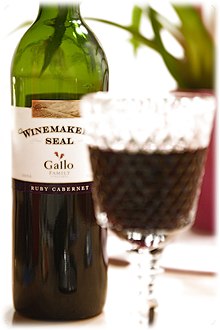Olmo grapes

Olmo grapesarewineand tablegrape varietiesproduced byUniversity of California, Davisviticulturist Dr.Harold Olmo.Over the course of his nearly 50-year career, Dr. Olmo bred a wide variety of both grapes by means of bothcrossingvarieties from the same species or creatinghybrid grapesfromcultivarsof differentVitisspecies.
Over 30 new grape varieties were created by Dr. Olmo and introduced to theCalifornia wineand table grape industries.[1]
Ruby Cabernet
[edit]
Ruby Cabernetis the most notable and widely planted Olmo grape. It is a cross between theVitis viniferavarietiesCabernet SauvignonandCarignanthat was first trialed by Dr. Olmo in 1936 before being released in 1948. The grape is primarily used in blending, adding color and tartness, but producers such asE & J Gallo Wineryhave produced varietal wines from the grape. According to wine expertJancis Robinson,Ruby Cabernet can have somearomasreminiscent of a youngCabernet Sauvignonwith the color of a Carignan but it lacks the structure andbodyto produce premium wines.[2]
In California, the variety is widely planted in theCentral Valleywhere it can withstand the hotcontinental climateof the valley and still produceharvestyields of 6 to 9 tons an acre.[2]Outside of California, the variety can also be found inAustralia,Argentina,Chile,IsraelandSouth Africa.
Rubired
[edit]Rubiredis a hybrid of theviniferavarietyTinto CãoandAlicante Ganzin,which itself is a hybrid ofVitis rupestrisArmon Rupestris Ganzin No. 4and theviniferacrossingAlicante Bouschet.Trial breeding and testing were completed by Olmo in 1958.[2]
Like Ruby Cabernet, it was bred to produce significantyieldsin hot climates, and in the California Central Valley it regularly yields 8 to 10 tons per acre. However, Rubired is ateinturiervariety withpigmented,instead of clear, juice. Most red wine grapes have clear juice, the red color of wines coming fromextraction of pigment from the grape skins.Rubired was originally intended for producingfortifiedport-style wines,and since the late 20th century, producers in Australia have included it in some port-style blends. Its intensely dark color is often useful in blending to intensify the color of other red wines, but it can also be used to createvarietalwines.[2]
Emerald Riesling
[edit]Emerald Riesling is a white wine grape crossing between theviniferavarietiesRieslingandMuscadelle.Trials on the variety began in 1936 and the variety was released in 1948 at the same time as Ruby Cabernet. Unlike many of the cool-climate Riesling crossings produced inGermanyat facilities likeGeisenheim Grape Breeding Institute,the Emerald Riesling was bred for warm climates like theSan Joaquin Valleyof California where today more than half of all Emerald Riesling plantings are found. Outside of California, there are limited plantings in South Africa.[2]It is also used quite extensively in Israel, where big wineries use it to produce light, and aromatic - usually off-dry - wines. It comprises roughly 2.6% of the total grape production in Israel, totaling (in 2012) 1,408 tons.[3]
According to wine expert Jancis Robinson, Emerald Riesling produces an aromatic, highacidwine that does not quite have the flavor definition more commonly associated with Riesling or its cool climate crossings. In cooler climate areas where it has been planted, such as theMonterey AVA,it can share some traits with Riesling but with a distinctly fuller body.[2]
Emerald Riesling is also known under the synonyms California 1139 E 29, Emerald Rizling, and Riesling Izumrudnii.[4]
Other wine grapes
[edit]
- Carnelian is a crossing of theVitis viniferaCarignan and a separateviniferacrossing between Cabernet Sauvignon andGrenache.It was created in 1972 to combine the genetic traits that allow Carignan and Grenache to produce well in warm climates with some of flavor and wine characteristics of Cabernet Sauvignon.[1]
- Centurian (also known asCenturion) is aviniferacrossing between Carignan and a separate crossing of Cabernet Sauvignon and Grenache. The grape was developed by Dr Olmo in 1975 matching the same grape varieties used to produce the Carnelian grape a few years earlier. Today it is mostly planted in the Central Valley of California.[5]
- Florais a crossing of twoviniferavarieties,SemillonandGewürztraminer,that was created in 1938 by Dr. Olmo at theCalifornia Agricultural Experiment Station.[6][7]A separate red Flora hybrid exist but it is not related in any way to the Olmo Flora.[8]
- Royaltyis a crossing of theVitis viniferaTrousseau grisvariety from theJura wineregion ofFranceand the teinturier grapeAlicante Ganzinthat, itself, is a hybrid of aVitis rupestrisvariety and theVitis viniferagrapeAramon.[9]The variety was first developed in 1938 but wasn't released for commercial use until 1958 when it was released with Rubired.[10]
- Symphony is a crossing of theviniferavarietiesMuscat of AlexandriaandGrenache gris.that Dr. Olmo first began developing in 1948. It took over 30 years to complete crossing trials and produce a viable cultivar. Symphony was finally completed and introduced commercially in 1981 andpatentedin 1983. The grape makes a white wine with a slight spiciness withtree fruitaromasofcitrus,apricotandpeach.It is primarily a blending grape but can be made into avarietalwine.
See also
[edit]References
[edit]- ^abJ Janick, James Troop Professor in Horticulture, Purdue University, USA, R E Paull, Department Chair, Professor of Horticulture, University of Hawaii at Manoa, USA (2008).The encyclopedia of fruit & nuts.CABI International. p. 918.ISBN978-0-85199-638-7.
{{cite book}}:CS1 maint: multiple names: authors list (link) - ^abcdefRobinson, JancisVines, Grapes & WinesMitchell Beazley pgs 226-227, 264-265 1986ISBN1-85732-999-6
- ^[1]Israel Wine Board, 2012
- ^Emerald Riesling,Vitis International Variety Catalogue,accessed 2010-07-15
- ^J. RobinsonJancis Robinson's Guide to Wine Grapespg 46 Oxford University Press 1996ISBN0-19-860098-4
- ^J. RobinsonJancis Robinson's Wine CourseThird Edition pg 109 Abbeville Press 2003ISBN0-7892-0883-0
- ^Vitis International Variety Catalogue: Flora (blanc)Archived2012-04-05 at theWayback Machine,accessed on October 20, 2008
- ^Vitis International Variety Catalogue: Flora (rouge)Archived2012-04-05 at theWayback Machine,accessed on October 20, 2008
- ^J. RobinsonVines Grapes & Winespg 226 Mitchell Beazley 1986ISBN1-85732-999-6
- ^J. RobinsonJancis Robinson's Guide to Wine Grapespg 161 Oxford University Press 1996ISBN0198600984
